Workout After Eating: How Long to Wait by Meal and Intensity
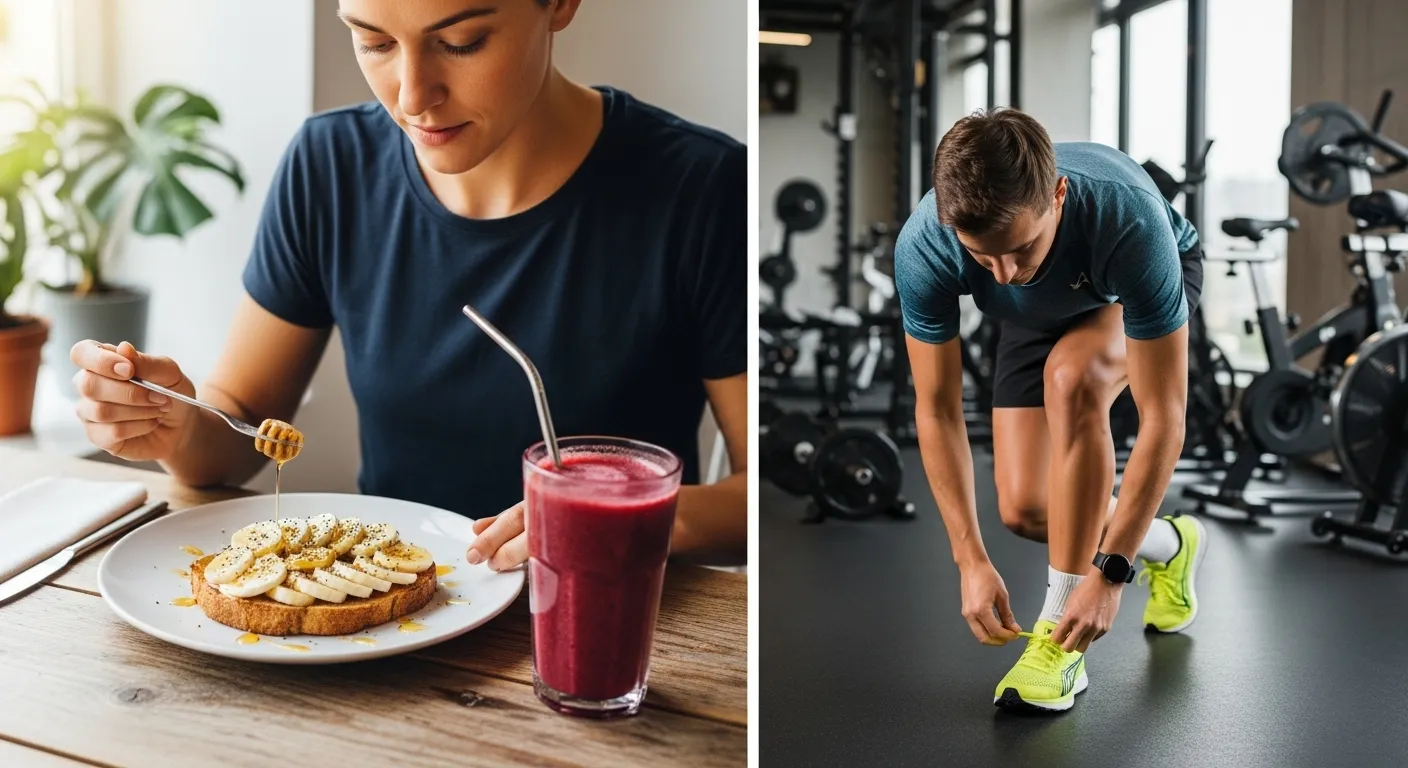
People ask me “how long should you wait to workout after eating” like I’m the stomach police. In my experience, it depends on what you ate, the workout, and your own digestion time. Big meal? Wait longer. Small snack? Quicker. Think pre-workout meal, cramps, bloating, fasted cardio, and my favorite gastric emptying.
I’ve coached folks for over ten years, and I’ve learned two things.
One: your gut has opinions.
Two: your plans do not impress it.
If you want a simple rule, the Mayo Clinic’s exercise basics are a solid sanity check when you’re trying to match food and movement.
The Short Answer (and Why It Depends)
If you want fast and dirty guidelines, here’s what I use with clients and with my own stubborn body. Light snack? 15 to 60 minutes. Small meal? 1 to 2 hours. Big meal with lots of fat or fiber? 2 to 4 hours. Heavy lifting or high-intensity intervals? More time than easy walking or light cycling.
I’ve always found that running on a full stomach is like trying to sprint with a backpack full of soup. Resistance training is more forgiving, unless you’re maxing out. Yoga inversions on a full belly? That’s a hard no from me.
Why Your Stomach Reacts the Way It Does
Food needs to leave the stomach at its own pace, a process known as gastric emptying. Fat, fiber, and big portions slow it down. Liquids and simple carbs move faster. Your stomach doesn’t care about your schedule. It’s busy being a stomach.

Meal Size vs. Wait Time: What Actually Works
Here’s a quick cheat sheet I’ve built over many test runs, mistakes, and a few tragic burpees.
| Meal size/type | Example | Suggested wait | Why it works |
|---|---|---|---|
| Very small snack | Half banana, a few crackers, small applesauce | 15 to 30 minutes | Fast digesting carbs, low fat/fiber |
| Small snack | Banana + a bit of peanut butter, small yogurt, rice cake | 30 to 60 minutes | Light protein/fat slows it just enough |
| Small meal | Oatmeal with berries, toast + egg, smoothie | 1 to 2 hours | Balanced carbs/protein; moderate volume |
| Medium meal | Chicken wrap, burrito bowl (go easy on cheese/beans) | 2 to 3 hours | More fiber/fat; more total volume |
| Large meal | Burger + fries, heavy pasta, big brunch | 3 to 4 hours | High fat slows gastric emptying a lot |
Workout Type Matters More Than You Think
Intensity and bouncing make digestion angry. Low-intensity steady cardio is pretty chill after a light snack. Sprinting, plyometrics, CrossFit metcons, and hard intervals? Those demand more time.
| Activity | Intensity | Wait window after small meal | Notes |
|---|---|---|---|
| Easy walk | Low | 0 to 30 minutes | Great after meals; also helps digestion |
| Light cycling | Low to moderate | 30 to 60 minutes | Stable torso, low jostling |
| Strength training | Moderate to high | 60 to 120 minutes | Longer if maxing or doing heavy compounds |
| Running | Moderate to high | 90 to 180 minutes | Impact + core tension = wait longer |
| HIIT/Metcons | High | 120 to 180 minutes | Lots of bouncing and intensity |
| Yoga (inversions) | Varies | 90 to 180 minutes | Upside down + full stomach = nope |
They will remind you what you had for lunch.
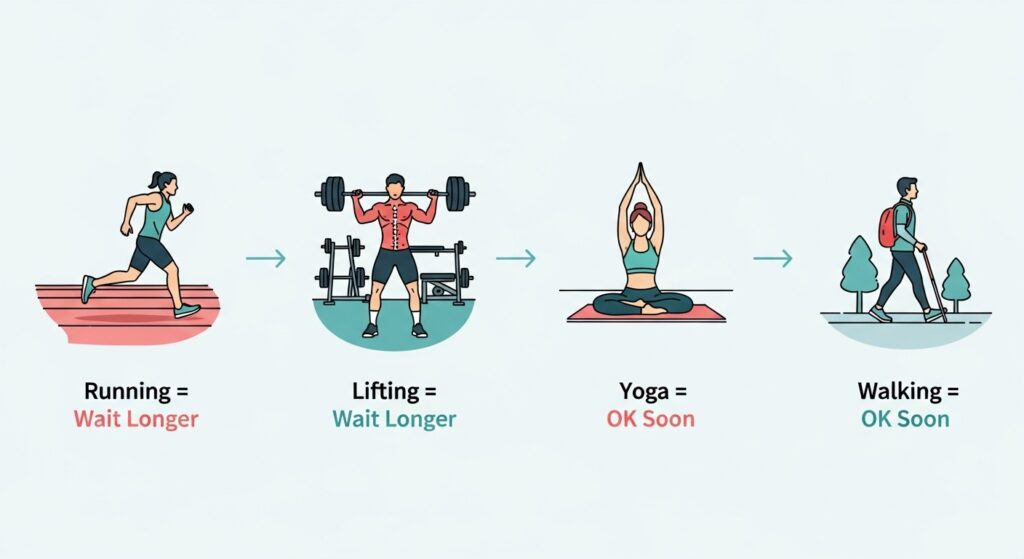
What to Eat Before a Workout (Without Regret)
For simple pre-workout fuel, carbs are the MVP. Fruit, toast, oatmeal, low-fat yogurt, rice cakes. Keep fat and fiber low if you’re training soon. If you’ve got more time, add protein. If you want deeper recommendations and recipes, I stash those in my running list of nutrition guides.
If you like formal rules more than my cranky gut wisdom, the NHS guide on food and exercise gives plain advice on carbs, fat, and timing. Worth a skim before your next “I’ll be fine” pre-run burrito.
What Happens If You Don’t Wait Long Enough
Here’s the short list, side stitches, reflux, bathroom sprints, nausea, sluggish pace, random rage at the universe. I’ve done all these. Once I tried burpees 20 minutes after pizza. That workout ended with me negotiating with gravity.
Some people ask me “how long should you wait to workout after eating” like there’s a magic number. There isn’t. There’s your stomach, your workout, and your last three meals doing parkour together. Track your patterns. You’ll see what works and what blows up.
Fast Food vs. Real Food (Big Difference)
It’s not just the clock. It’s quality. High-fat fast food hangs out in your stomach like a stubborn tenant. Simple, lower-fat meals glide through. If you want a polite, public service explanation that’s less ranty than me, check Better Health Victoria on exercise and eating.
Walking After Meals: The Most Underrated Move
Easy walks right after eating? Love them. They help blood sugar, feel good, and don’t demand a long waiting period. Ten to twenty minutes at a talkable pace. Not a power march. Save your heroics for later.
How I Time My Own Training Days
When I lift heavy, I give myself at least 90 minutes after a small meal. If I’m going to run hard, I aim for two hours. If life happens and I’m stuck with 30 minutes, I pick a tiny snack, half a banana, some pretzels and keep the workout easy. It’s not rocket science. It’s more like weather forecasts. Often right. Sometimes chaos.
For athletes with tight schedules or double sessions, I keep a playbook by sport and by guts. I ramble about this kind of thing a lot under my notes on fitness for athletes.
Fasted Workouts: Are They Worth It?
Short answer, sometimes. Easy to moderate cardio on an empty stomach can be fine. Might even feel great. High-intensity? Usually worse. Lifting heavy? I prefer some carbs in the tank. If you want to see a neutral take, here’s a piece on exercise on an empty stomach. Try both ways and take notes. Your body will vote loudly.
Hydration: The Forgotten Pre-Workout Rule
People obsess over food timing and forget water. Dehydration makes nausea and cramps worse. Sip water across the day. Electrolytes matter in long, hot, or sweaty sessions. No, you don’t need to chug. Yes, you should show up hydrated.

Common Body Signals (And What to Do About Them)
Heavy Stomach
Feels like a brick. Solution: extend the warm-up. Start slower. Add 10 to 15 minutes of time since last bite next time. Re-check meal fat and fiber.
Acid Reflux
Burning in the throat or chest. Solution: wait longer, avoid spicy/acidic foods pre-workout, and go easy on coffee. GERD folks, lift torso in warm-ups and pick low-impact cardio.
Side Stitch
Annoying sharp pain under the ribs. Solution: teach your breath to be steady, exhale on the opposite foot strike, and don’t start sprints after a meal. Core work helps over time.
Bathroom Emergency
You know the one. Solution is here, keep fiber low pre-training, avoid sugar alcohols, and test your snacks on easy days before big workouts. Not during race week. Please.
When in Doubt, Test It Yourself
I keep a simple log. What I ate, when I ate it, what I did, how it felt. Patterns jump out fast. This is also how I dial in pre-race meals, long ride snacks, and weird travel days. If you like structured ideas for staying safe while testing, I’ve got an archive on injury prevention that pairs well with meal timing experiments.
What the Pros Do (and What Normal People Can Steal)
Pros can time meals like a science project. They also have chefs and not-real-life schedules. For the rest of us, two rules help: plan your sessions and reverse-engineer your meals, or pick the workout that matches your last meal. If you want session templates and messy real-life hacks, my pile of coaching tips might save you from a few regret-burpees.
If you’re coming back from a tweak or a long break, timing matters even more. Keep meals simpler, cut intensity, and let your gut catch up. If knees are part of your story, I wrote a practical knee injury rehab plan that shows how to restart training without being a hero on day one.
Real Guidelines I Use with Clients
- Big meal: Wait 3 to 4 hours for hard stuff. 1 to 2 hours for easy stuff.
- Small meal: 1 to 2 hours before hard. 30 to 60 minutes before easy.
- Tiny snack: 15 to 45 minutes before easy. 45 to 60 minutes before moderate.
- If it’s high fat: high fiber, or spicy, add time. Sometimes a lot.
- If your workout is high-impact or high-intensity: add time.
- When in doubt: start easy and build.

Real-Life Scenarios for Different Training Times
Morning Run at 6:30 a.m
Option A: Fasted easy run for 30–45 minutes. Option B: Half a banana or small applesauce at 6:00, out the door at 6:30. Hard intervals? Eat more, wait longer, or move them later.
Lunch Lift at Noon
Breakfast at 8:30 with carbs and protein. Small pre-lift snack at 11:15 if you need it (rice cake, yogurt). Lift at 12:00. Heavy squats planned? Keep the snack small and simple and give it 45 minutes.
Evening Class After Dinner
If dinner is big, eat at 5:00. Or split it: small plate at 5:00, second small plate at 8:30. If you must eat at 6:00, keep it light and low fat, then pick a lower-intensity class.
Long Ride on Saturday
Eat a regular breakfast 2 to 3 hours before. Take fuel on the bike. Liquids and gels are your friend for keeping the gut calm. Don’t cram a giant meal on the start line unless you enjoy chaos.
Reliable Guides and Science-Based Sources
If you want more formal reading without my jokes, skim a couple of mainstream sources and come back to your notes. Start with a basic overview like the nutrition guides I keep linked on my site for big-picture context.
Then cross-check tips with something like the NHS guide on food and exercise for simple, practical timing and snack ideas.
Edge Cases Nobody Warns You About
High Caffeine + Heavy Meal
That latte plus cheesy pasta before HIIT? Disaster combo. Caffeine speeds things up, heavy food slows them down, and your gut becomes a tug-of-war. I’ve done it. I don’t recommend it.
Heat and Humidity
Hot days slow you down and upset the stomach faster. Eat simpler, drink more, and give yourself extra time. Don’t try to be a hero with a burrito and hill sprints at noon in July.
Race Day Nerves
Anxiety speeds up the gut. That means you often need simpler food and earlier eating. Don’t wait until race day to figure it out. Practice your pre-race meal on normal days, same timing, same foods.
Fiber Bombs
Beans, big salads, whole grains with lots of roughage awesome for life. Risky an hour before a speed workout. You can still eat fiber. Just time it away from hard sessions. Your gut will thank you quietly, which is better than loudly.
New to Timing Meals and Workouts? Start Simple
Start with small changes. Swap heavy pre-workout meals for smaller, lower-fat ones. Add more time before intense sessions. Keep a simple log for two weeks. After that, you’ll know way more about your stomach than most internet lists will tell you.
If you want a no-frills explainer without my sarcasm, the Mayo Clinic on exercise has a reliable overview you can pair with your notes and what you learn in practice.

Quick Reference Table (Bookmark This One)
| Last thing you ate | What you plan to do | Safe wait |
|---|---|---|
| Small fruit or gel | Easy cardio | 0 to 30 min |
| Toast + egg | Strength session | 60 to 90 min |
| Oatmeal + yogurt | Tempo run | 90 to 120 min |
| Big sandwich + chips | HIIT class | 2 to 3 hours |
| Heaviest brunch of your life | Anything that makes you breathe hard | 3 to 4 hours (or skip and walk) |
The Real Point About Food Timing
Timing is a tool, not a rule. Use it to make workouts feel better, not to stress yourself out. Eat enough. Keep pre-workout food simple. Match the wait time to the intensity. And if your gut says “nope,” pivot and live to train another day.
And yes, I get that everyone wants an exact minute count. Fine. For most folks, 1 to 2 hours after a small meal is the sweet spot for anything moderate. But hey, that’s me. Your stomach will have its own opinions, and you’ll learn them fast by paying attention.
FAQs
- How do I stop side stitches if I ate too close to my run?
Slow down for 5 to 10 minutes, exhale on the opposite foot strike, and add more time before your next run. Eat less fat/fiber pre-run. - Is it bad to lift weights right after dinner?
Not “bad,” just uncomfortable. If dinner is big, I’d wait 2 to 3 hours or lift earlier. Or split dinner into two smaller meals around the workout. - What should I eat 30 minutes before a workout?
Small, low-fat carbs. Half a banana, a few pretzels, applesauce, or a small yogurt if dairy sits well with you. - Can I walk right after eating?
Yes. Easy walking is great post-meal. Keep it chill. Save sprints and burpees for later. - Do protein shakes sit well before training?
Usually better than heavy food. If it’s thick or dairy-heavy, give it 45 to 60 minutes. Clear carb drinks digest even faster.
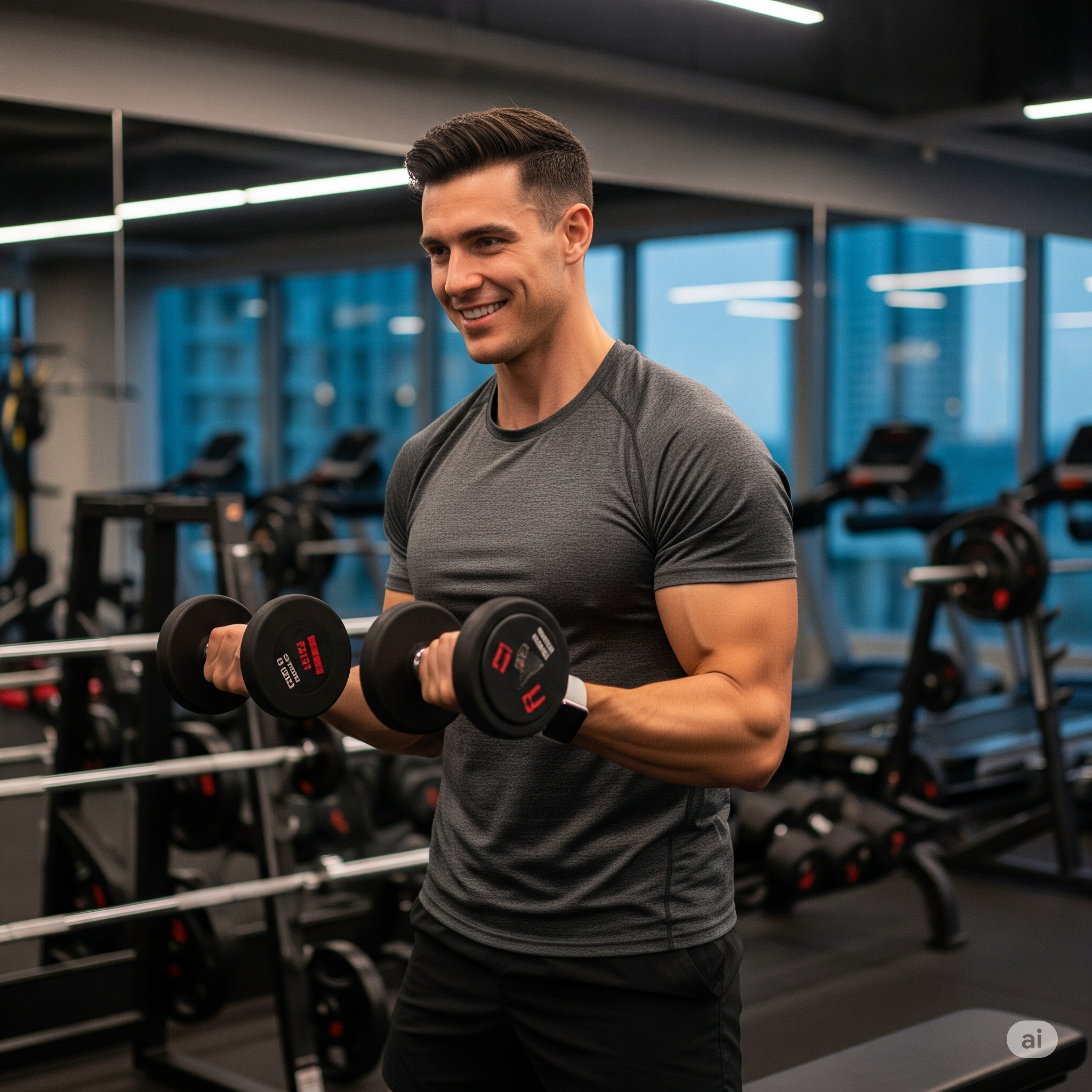
I’m Benjamin Clark, dedicated to elevating your athletic performance. Get targeted fitness plans, injury prevention techniques, sports psychology insights, and the latest in nutrition. Let’s train smarter.

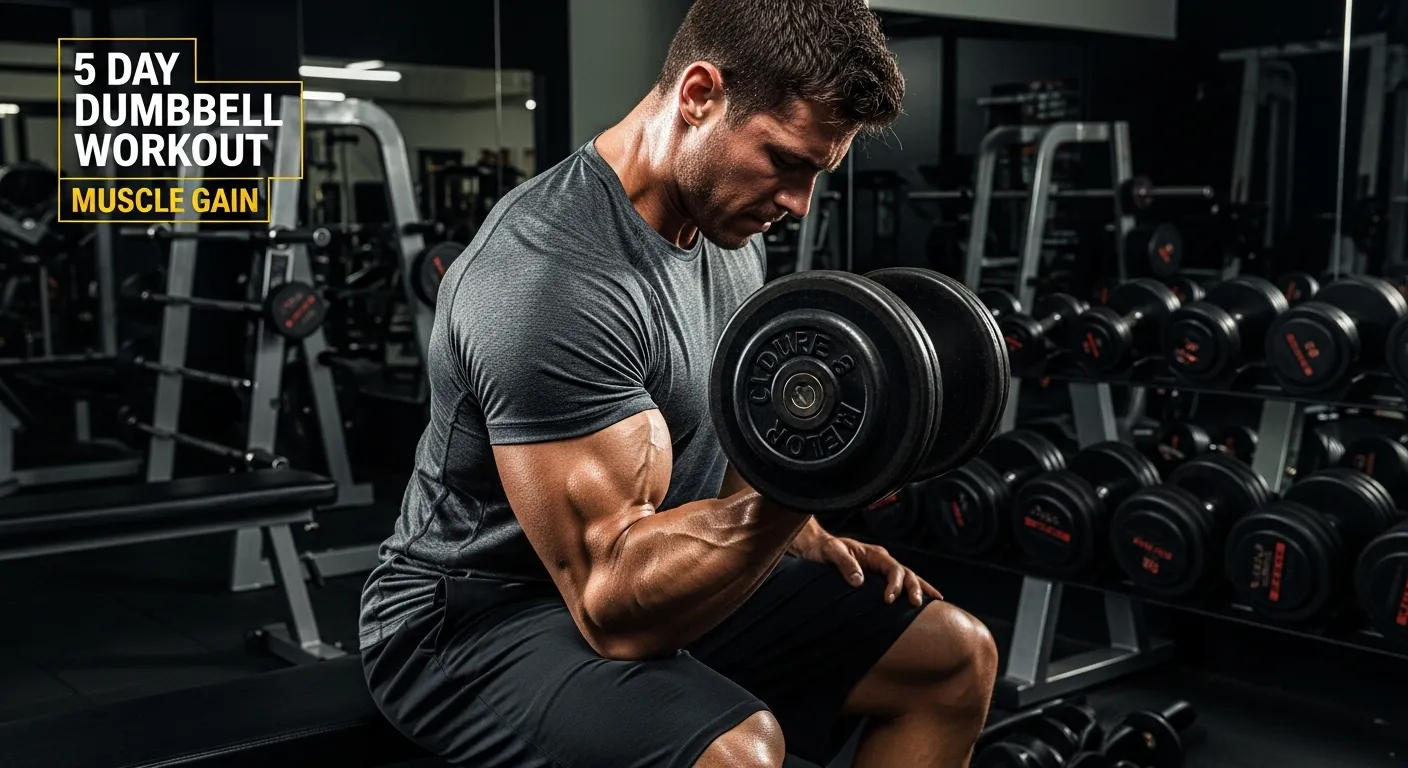
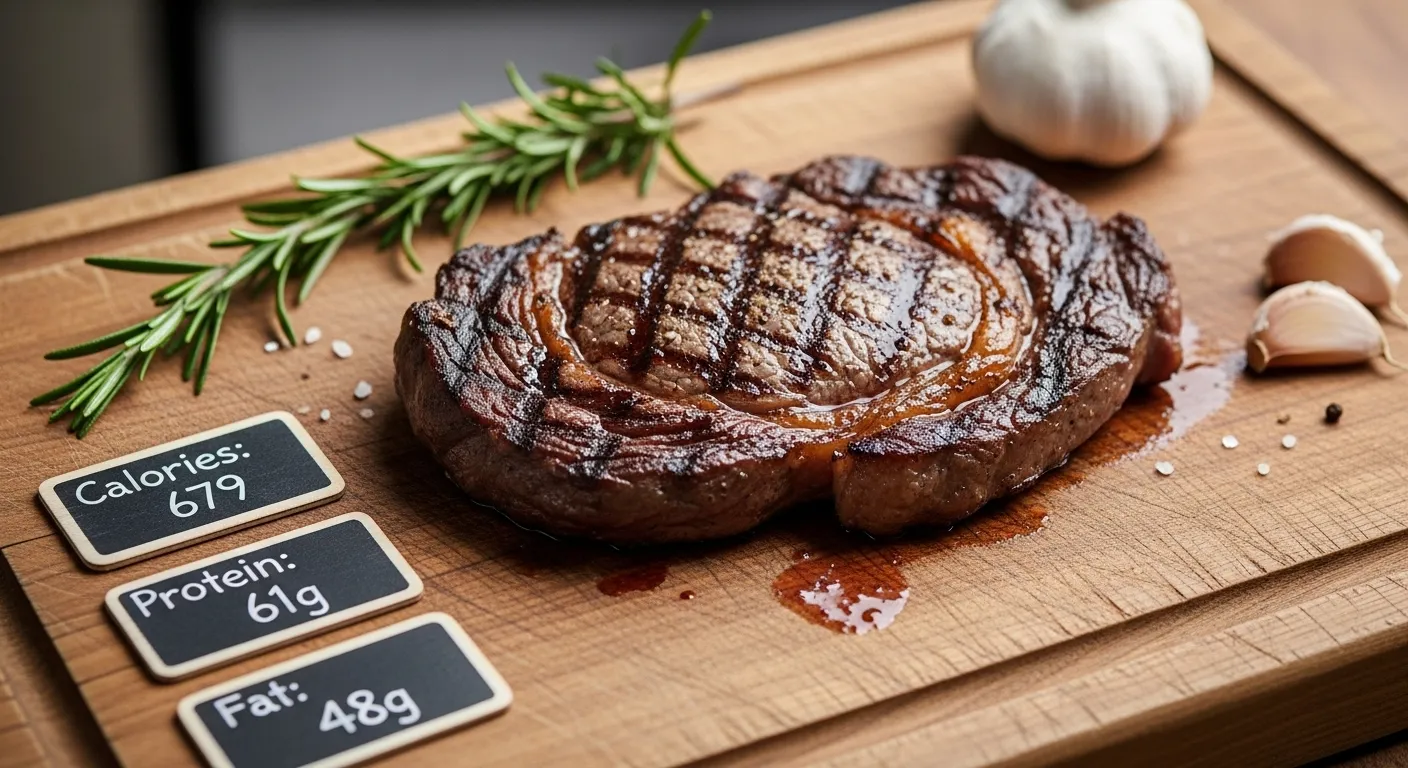
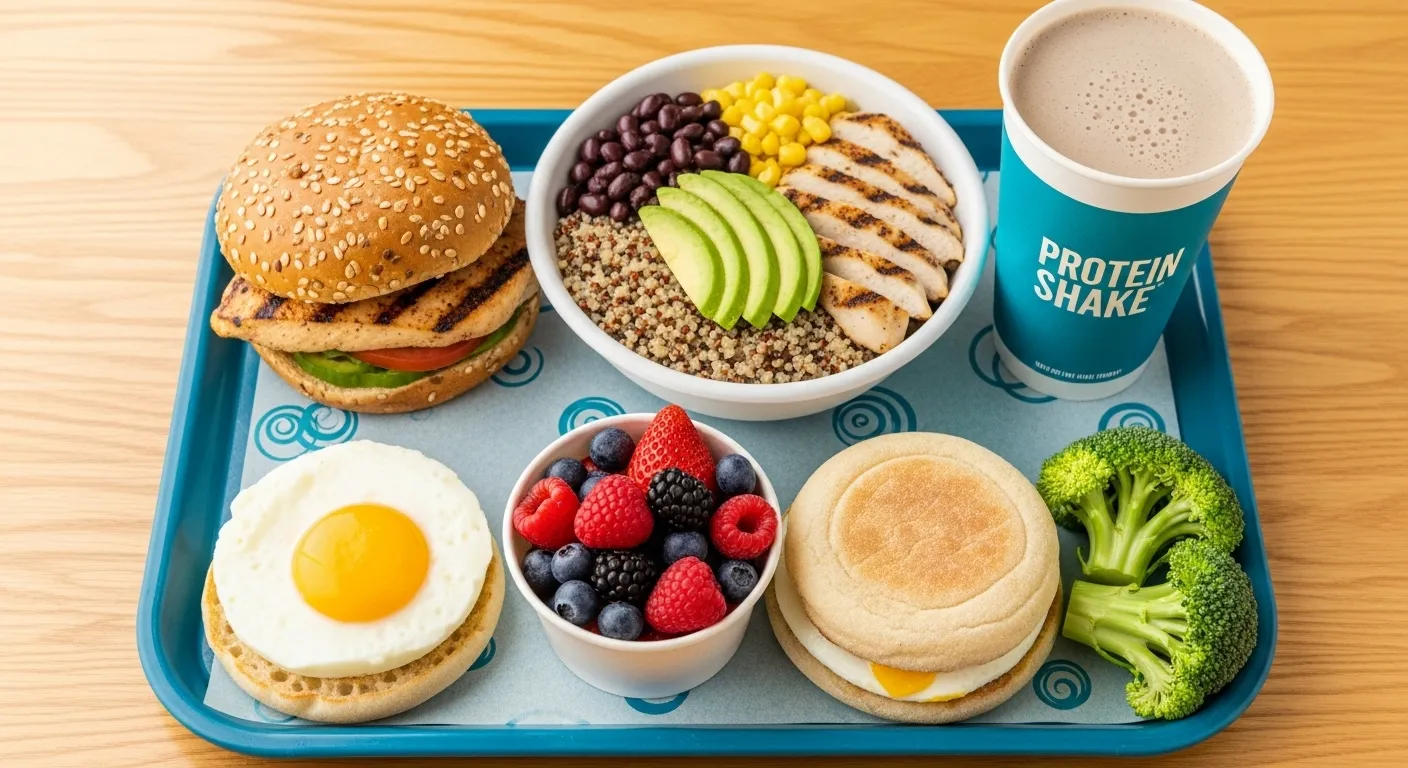
So you’re telling me scarfing down pizza and then squatting 200lbs is NOT peak fitness? 😅 good guide tho, I’ll actually wait next time.
How do meal types affect wait time with different workout intensities?